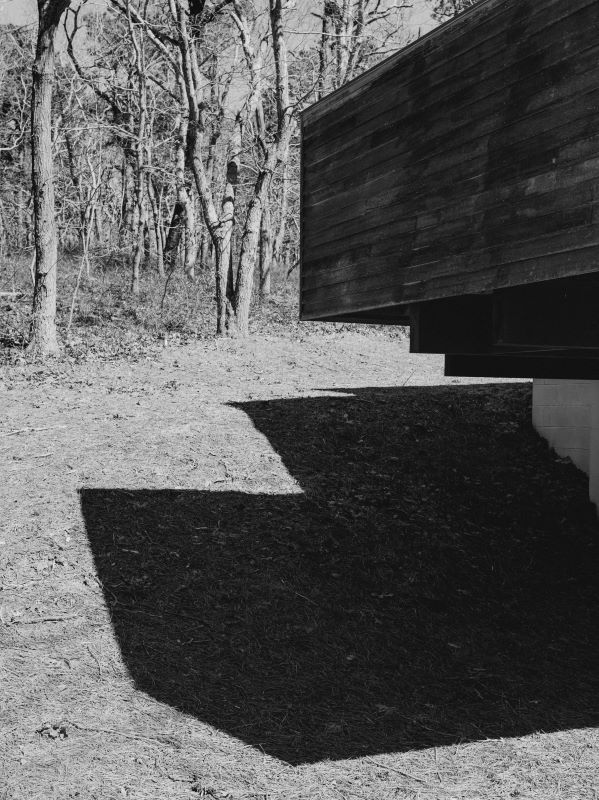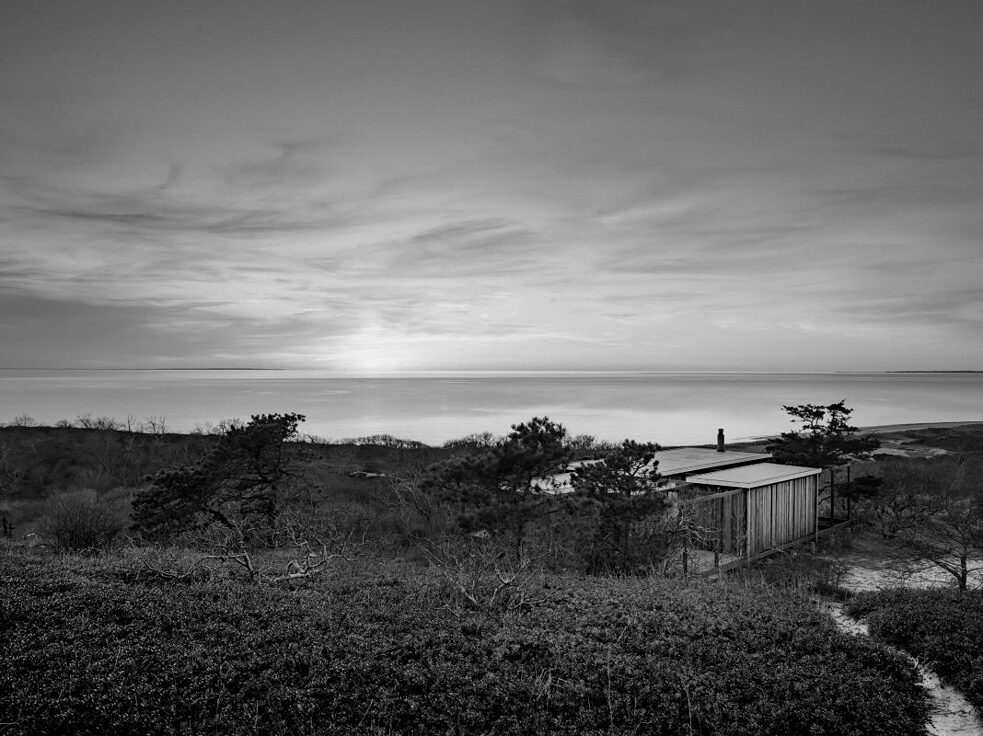Peter McMahon
A Refuge for New Ideas

During the Depression many rural New England towns were isolated, and sparsely populated, especially on outer Cape Cod. Photographs of Truro from the 1930s show small boxy houses, temporary outposts in a treeless, desolate moor. However, the New England coast soon proved to be fertile ground for new ideas from across the Atlantic.
In 1937, after being offered a position at Harvard, Bauhaus founder Walter Gropius decamped from a turbulent Europe to spend the summer at a beach on Cape Cod, with members of his inner circle, including Marcel Breuer, László Moholy-Nagy, Xanti Schawinsky and Herbert Bayer. Sunbathing and vigorous outdoor activity was central to Bauhaus culture from the start.
In founding the Bauhaus, Gropius had sought to reconcile what seemed opposites: the continuum of traditional craft in wood, textiles, metal, and the visual and performing arts with the currents of radical aesthetic theories and the new materials and methods of the machine age. Though under constant pressure from hostile officials and the general chaos of Germany between the wars, the school was remarkably successful. It produced iconic work in all these fields as well as many patents for new furniture manufacturing and weaving processes. More importantly, it developed an approach to teaching design, based on discovering the essential nature of materials and practices, which proved to be enduring, as well as portable.
 Private Residence, Six Moon Hill, Lexington, MA, Designed by The Architects Collaborative, 1950
| © Mark Römisch
After their Cape Cod sojourn, Gropius and his cohort wasted little time in partnering with existing institutions, like the Museum of Modern Art, and assisted in the creation of new ones like Harvard’s Graduate School of Design, Chicago’s New Bauhaus, Black Mountain College, and the Aspen Institute. The influence these refugees had on life in the US, from city planning to the fonts on business letterheads, is difficult to overstate.
Private Residence, Six Moon Hill, Lexington, MA, Designed by The Architects Collaborative, 1950
| © Mark Römisch
After their Cape Cod sojourn, Gropius and his cohort wasted little time in partnering with existing institutions, like the Museum of Modern Art, and assisted in the creation of new ones like Harvard’s Graduate School of Design, Chicago’s New Bauhaus, Black Mountain College, and the Aspen Institute. The influence these refugees had on life in the US, from city planning to the fonts on business letterheads, is difficult to overstate.
At Harvard, Gropius and Breuer served as indispensable mentors to a generation of critical post-war American architects including Paul Rudolph, Phillip Johnson, I.M. Pei, Eliot Noyes, Edward Larrabee Barnes, and many others.
The pair also formed an architectural partnership in the lean times leading up to World War II. The main output of the office was a collection of houses surrounding Boston which retained the cubic, white, multi-story forms of the villas they had built in Europe but traded their stuccoed-masonry vocabulary for the local wood-clad vernacular. Both Gropius and Breuer wrote of their admiration for the unadorned, Yankee functionalism they found in colonial farmhouses.
Soon after arriving they built houses for themselves, side by side, in the pastoral community of Lincoln (an easy commute from Cambridge), and both buildings can be seen as New England vernacular viewed through a cubist prism. The wooden structural frame, painted-wood siding (here applied vertically), fieldstone walls, and brick chimney are in keeping with the antique houses nearby, but the essential components of the houses have been deconstructed and recombined in dramatic ways.
The Gropius house, though an elongated box, has parts of its volume subtracted to make a roof deck and a minimalist colonnade, while a covered entryway and screen porch are jutting appendages. Aside from traditional materials, the house employs elements hitherto considered ‘industrial’ such as steel pipe columns and casement windows, glass block, and cork flooring. Rather than merely providing a defensible refuge, the house offers a variety of sheltered spaces from which to enjoy nature: the roof deck, the screen porch and the living/dining room with its large steel-sash windows, opening to the piney woods and open fields.
In the mid-1940s, around the time Breuer broke free to start his own office, Gropius and a group of young partners formed The Architects Collaborative (TAC). This group combined forces to buy twenty acres, nearby in Lexington, as a site for a collectivist community of modern homes, which shared standard amenities, informed by the Bauhaus’ progressive social, as well as aesthetic, ideals. They named the community Six Moon Hill. Carefully sited for privacy, the houses present ribbon windows to the street while opening to the yards with entire walls of glass as seen on pg. 60. This deep focal range here projects the viewer out into the budding landscape.
Around the same time, Gropius, Breuer and Schawinsky, with family, friends and kindred spirits, found their way back out to the Cape, eventually building scores of avant-garde summer cabins around secluded ponds and hollows. As opposed to the year-round Six Moon Hill houses these were mostly small, unheated and low budget, but they often manifested the undiluted design thinking of their makers.
Mark Römisch’s photographs illustrate some seldom-seen aspects of these summer cottages and their settings. The inherent dichotomy between the Cape’s soft, velvety air and sweet water ponds and the violent storms and churning tides that constantly chop away at its shoreline is reflected in the ambivalent attitude of these experimental cottages towards the Cape’s dual nature, in that they seek to merge with and yet remain discrete from the untamed terrain.
 Breuer House, Wellfleet, MA, Designed by Marcel Breuer, 1944
| © Mark Römisch
Close to the Bauhaus’ original coastal beachhead, some of the Cape’s modern cottages sat vacant for decades and fell into ruin, the human-made elements giving way to the forces of weather and time. It has been my vocation to restore several of these buildings to their original state and my pleasure to see them so thoughtfully considered in Mark Römisch’s photographs.
Breuer House, Wellfleet, MA, Designed by Marcel Breuer, 1944
| © Mark Römisch
Close to the Bauhaus’ original coastal beachhead, some of the Cape’s modern cottages sat vacant for decades and fell into ruin, the human-made elements giving way to the forces of weather and time. It has been my vocation to restore several of these buildings to their original state and my pleasure to see them so thoughtfully considered in Mark Römisch’s photographs.Peter McMahon
Peter McMahon is the Founding Director of the Cape Cod Modern House Trust, incorporated in 2007 to archive, restore and celebrate the Outer Cape’s outstanding modern architecture and the creative culture that surrounded it. He is co-author, along with Christine Cipriani, of Cape Cod Modern, Mid-Century Architecture and Community on the Outer Cape, 2014, Metropolis Books. His design practice in South Wellfleet focuses on sustainable, modern architecture and restoration of mid-20th century buildings.










